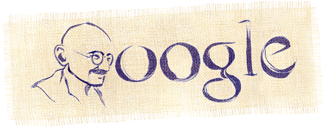


10/02/2009
Google is honoring Gandhi’s Birthday with one of their doodles:
Click for a search on Gandhi’s name. But Richard Grenier’s great essay, The Gandhi Nobody Knows, Commentary, March 1983, isn’t one of the top 10 results — it probably should be:
Anti-racism: the reader will have noticed that in the present-day community of nations South Africa is a pariah. [VDARE.com note: In 1983, yes, but not any more.]So it is an absolutely amazing piece of good fortune that Gandhi, born the son of the Prime Minister of a tiny Indian principality and received as an attorney at the bar of the Middle Temple in London, should have begun his climb to greatness as a member of the small Indian community in, precisely, South Africa. Natal, then a separate colony, wanted to limit Indian immigration and, as part of the government program, ordered Indians to carry identity papers (an action not without similarities to measures under consideration in the U.S. today to control illegal immigration). The film’s lengthy opening sequences are devoted to Gandhi’s leadership in the fight against Indians carrying their identity papers (burning their registration cards), with for good measure Gandhi being expelled from the first-class section of a railway train, and Gandhi being asked by whites to step off the sidewalk. This inspired young Indian leader calls, in the film, for interracial harmony, for people to "live together".Now the time is 1893, and Gandhi is a “caste” Hindu, and from one of the higher castes. Although, later, he was to call for improving the lot of India’s Untouchables, he was not to have any serious misgivings about the fundamentals of the caste system for about another thirty years, and even then his doubts, to my way of thinking, were rather minor. In the India in which Gandhi grew up, and had only recently left, some castes could enter the courtyards of certain Hindu temples, while others could not. Some castes were forbidden to use the village well. Others were compelled to live outside the village, still others to leave the road at the approach of a person of higher caste and perpetually to call out, giving warning, so that no one would be polluted by their proximity. The endless intricacies of Hindu caste by-laws varied somewhat region by region, but in Madras, where most South African Indians were from, while a Nayar could pollute a man of higher caste only by touching him, Kammalans polluted at a distance of 24 feet, toddy drawers at 36 feet, Pulayans and Cherumans at 48 feet, and beef-eating Paraiyans at 64 feet. All castes and the thousands of sub-castes were forbidden, needless to say, to marry, eat, or engage in social activity with any but members of their own group. In Gandhi’s native Gujarat a caste Hindu who had been polluted by touch had to perform extensive ritual ablutions or purify himself by drinking a holy beverage composed of milk, whey, and (what else?) cow dung.
Low-caste Hindus, in short, suffered humiliations in their native India compared to which the carrying of identity cards in South Africa was almost trivial In fact, Gandhi, to his credit, was to campaign strenuously in his later life for the reduction of caste barriers in India — a campaign almost invisible in the movie, of course, conveyed in only two glancing references, leaving the audience with the officially sponsored if historically astonishing notion that racism was introduced into India by the British. To present the Gandhi of 1893, a conventional caste Hindu, fresh from caste-ridden India where a Paraiyan could pollute at 64 feet, as the champion of interracial equalitarianism is one of the most brazen hypocrisies I have ever encountered in a serious movie.
I quoted this years ago when the SPLC first started calling us racist — it’s surprising how many people and things have been called racist. There’s a lot more — read the whole thing.